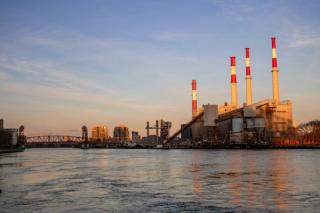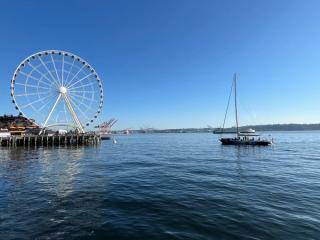
Product-focused emission reductions: Shifting to a life cycle perspective
by Selina Roman-White
View post

This is the third article in our series of insights exploring the evolving Waste & Resources sector. The first article explores the rapidly evolving sector and the second article explores how a business should begin its circular economy journey.
In this piece, Simon Gandy reflects on the growth of natural capital, social capital and water resilience as parts of company’s assessment of their impact on the environment. This is a development that means he is increasingly stepping into new aspects of sustainability, and working with a wider range of specialists, to keep pace in a discipline where, for most of his career, he has felt somewhat ahead of the wave. If you have challenges or questions in this area, why not get in touch with Simon and compare notes?
I started my career as an environmental consultant, initially working on producer responsibility projects for the UK government. At that time it felt like a niche market, though something that seemed destined to become more important. It wasn’t long before I started getting involved in the occasional life cycle assessment (LCA).
I spent approximately ten years (off and on) promoting the merits of LCAs. LCAs seek to evaluate the environmental impacts of a product, process or service across its entire life cycle, and against multiple environmental criteria. The theory is that LCAs can help prevent so-called ‘burden shifting’ where well-intended actions to mitigate a particular impact lead to potentially unforeseen impacts elsewhere in the life cycle and/or other criteria[i]. Over this period, I had a steady run of enlightened clients, but had to work hard to find them.
For me, the tide turned through 2015-17. Suddenly, I was pushing on an open door, and fascinating LCA projects fell into my lap. The subject matter was mind-bendingly broad – cable troughing, ammonia electricity storage, food waste digesters, a super-car engine, a brick, a timber I-joist, whisky by-products. The only commonalities across these projects were the desire of the clients to better understand their environmental impacts, and our ability to apply the flexible LCA technique to their particular requirements.
This trend continued for the years following, with demand steadily growing, and my team growing as well. Now, as I look to grow the team here at SLR Consulting, the challenge seems to be finding good LCA consultants who want to move (if you might be one, please get it touch!).
However, effective recruitment isn’t the only thing on my mind, nor the subject of this blog. Rather, I’m fascinated to see how savvy clients are stretching the boundaries of what they want to investigate. Traditionally, a client and the industry would consider up to about a dozen different environmental criteria in an LCA. What has changed more recently is the increasing interest in criteria that traditional LCA struggles to evaluate, in particular natural capital, social capital and water resilience.
The first of these, still within the realm of environmental impacts, concerns natural capital. Natural capital allows businesses, investors and legislators to value the impact of, or on, nature and natural resources in a similar way that financial measures measure investment capital. It is associated with considerations such as biodiversity net gain, where discrete projects are expected to leave their location in a better position than before they started. At SLR, we have a large team of ecologists who have been looking at projects from this angle for some time now. They perform natural capital baseline assessments, develop strategies and deliver stakeholder engagement programmes to help companies understand their risks and opportunities.
Over the past 18 months, my clients have increasingly wanted to broaden their impact assessments beyond merely environmental criteria and look at wider sustainability considerations. This most commonly concerns social capital, where our interest is helping companies, workers and communities along the supply chain in identifying shared value. Are the companies that make these products doing enough to ensure that their workforce is being treated fairly and communities are not inequitably impacted?
SLR’s credentials on the social side have been ramping up through organic growth and the acquisition of Corporate Citizenship. In a knowledge sharing meeting last month, I learned about some of the work my social impact colleagues do around climate justice, performing social and human rights impact assessments and working with lending banks to explore whether their investments are socially sound. Our experts talked about a Just Transition, sharing some of the work they are doing to help minimise the hardships for workers and communities as the world transitions towards a (carbon) net zero future. They look at intergenerational equality, labour and working conditions, gender and race equality. In the same meeting, colleagues from our Energy and Carbon team talked about how biodiversity has just been added to the main climate change questionnaire within the CDP disclosure programme.
Water resilience is yet another angle of interest. The UN is predicting that there will be a 40% shortfall in freshwater resources by 2030. While the focus to-date has been around curbing greenhouse gas emissions, there is a wave of net-zero pledges that focus on water. Our water experts are looking to help companies inspect their entire value chain to see how they can reduce the amount of water used, and how they can replenish more than they use.
To some extent, therefore, I feel like I’m back at the start of my Masters, wide-eyed at the bewildering range of angles from which environmental and social performance can be judged. However, whilst I have much to learn from my colleagues about natural capital, social capital and water resilience, I also bring many years of my own experience in product LCA. I’m really excited to see how we combine our disciplines to offer clients as holistic a service as they could imagine, looking at their organisations through a wide-angle lens and balancing out all those competing considerations to identify their best path forward. It’s going to be quite a ride, but I’m delighted to be surrounded by experts from whom I can continue to learn.
If you would like to talk about your challenges or questions in this area, do get in touch!
[i] Carbon footprints are a streamlined form of LCAs, but they lack that multi-criteria aspect so actions to reduce carbon emissions risk increasing impacts under other criteria that were not examined.

by Selina Roman-White

by Madison Edson, James Van Horne, Dr. Tecle Rufael, Selina Roman-White, Heather Matthews

by Jonathan Vallarta